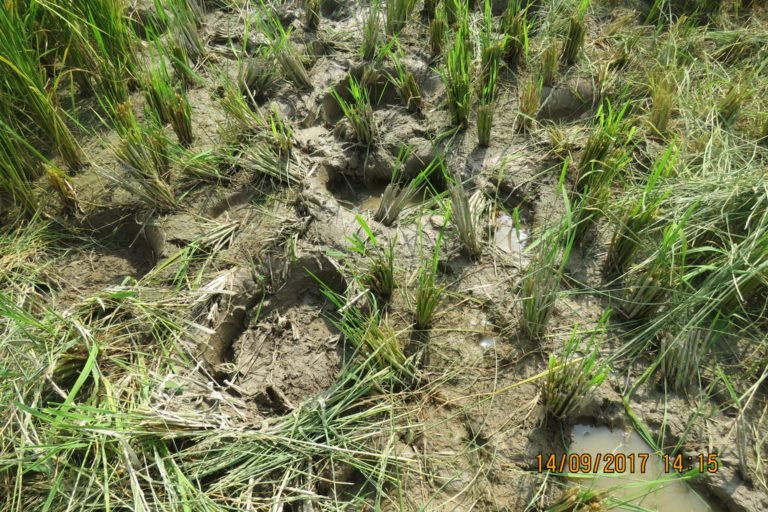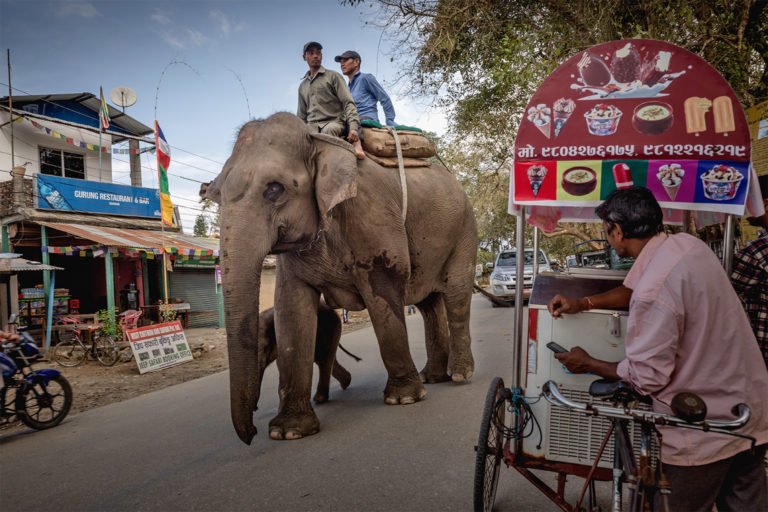- Conflict with humans is considered the biggest threat to Asian elephants in Nepal, says veteran conservationist Ashok Ram.
- Encounters between villagers and elephants typically occur when they stray into each other’s areas in search of food.
- Ram says there needs to be a landscape-level management approach to elephant conservation, given that the animals move freely between Nepal and India.
- In an interview with Mongabay, he explains the history of habitat fragmentation, why electric fences aren’t a solution to human-elephant conflict, and why mid-afternoon is the most dangerous time for encounters.
KATHMANDU — Throughout much of their range, Asian elephants are regarded as incarnations of the Hindu god Ganesh, the elephant-headed deity of wisdom. But in Nepal, as in neighboring India and across South Asia, this pachyderm that once roamed the entire floodplain of the Ganges is now restricted to a few patches of forest due to fragmentation of its habitat.
The lethal combination of poaching for ivory, destruction of habitat and conflict with humans has now pushed Asian elephants (Elephas maximus) into the endangered category on the IUCN Red List.
Of all the threats to the species’ survival, human-elephant conflict is seen as the most devastating. In Nepal alone, nearly 50 elephants have been killed in the span of 20 years in retaliation for eating farmers’ crops.
Ashok Ram, a 30-year veteran of Nepal’s Department of National Parks and Wildlife Conservation, has explored the root causes of human-elephant conflict and ways to address them. Ram, who recently completed his Ph.D. on the issue from Wildlife Institute of India, conducted extensive studies on how elephant habitat has been fragmented since the 1930s, and reviewed all cases of human casualties involving elephants in Nepal’s entire southern region.
Mongabay’s Abhaya Raj Joshi met Ram in Kathmandu recently to talk about his work, the threats elephants face in Nepal, and the way forward for the conservation of the species. The following interview has been translated from Nepali and edited for clarity.
Mongabay: Why did you decide to study elephants?
Ashok Ram: There are several reasons for that. Firstly, I have always been interested in big animals. As part of my bachelor’s thesis, I had looked at the impact of Mikania micrantha [an invasive plant species] on the greater one-horned rhinos [Rhinoceros unicornis]. Elephants caught my attention as they face an unprecedented crisis. As their numbers were rapidly declining, they were being killed for their ivory and they were also being electrocuted as a result of human-elephant conflict. Human casualties were also growing. I thought that this animal could go extinct if we don’t take appropriate steps to conserve it. Studying it in detail could be the first step toward its conservation.
Mongabay: Could you please briefly outline the scope and area of your research?
Ashok Ram: My research project was a bit ambitious. I decided to cover the entire 1,200-kilometer [about 750-mile] length of Nepal’s southern boundary. But as I knew that this would turn out to be a benchmark for other studies in the future, I decided to take on the challenge. I mainly looked at three aspects of human-elephant interactions. The first one was to assess how the habitat of elephants has changed over the past century. The second one was to analyze the root cause of human casualties in cases involving conflict with elephants and the third was to assess cases where elephants had died due to anthropogenic causes.
Mongabay: Let’s start with the changes in elephant habitat in Nepal. What were some of your findings?
Ashok Ram: Let me first tell you about how we went about studying the changes in habitat. We looked at forest cover maps obtained through multiple sources such as topographic maps and Landsat satellite images from 1930, 1975, 2000 and 2020 to compare how forest cover had changed during the periods in elephant range areas in the countries.
The images we saw corresponded with Nepal’s economic and political history. During the 1930s we saw dense continuous forests in Nepal’s plains. By 1975, large swaths of forests had been cleared for resettlement of poverty-stricken people from the hills. The government’s policy then was to resettle people from the hills, where agriculture was difficult, in the fertile plains where growing food to survive was comparatively easy. The images from 2020 show massive urbanization and concretization of land which was once covered with forests.
The elephants’ habitat, which spanned 30,000 square kilometers [11,600 square miles] in the 1930s, is now down to less than 19,000 km2 [7,300 mi2].
After collaring eight elephants to assess their home range, we found that an elephant roams an area of around 282-387 km2 [109-149 mi2]. One of the elephants we collared has an extended raise of 1,400 km2 [540 mi2]. This means that they have a relatively large home range compared to other species, and that they travel long distances in search of food. When their range is fragmented, they can’t move through their historical routes, and that increases instances of conflict with humans.
The development of roads and unplanned settlements has already halted the movement of big herds. Proposed railways and airports in the southern belt stand to aggravate the situation further. But loner male elephants still continue to move long distances, and most of them are involved in human-elephant conflict.
Mongabay: Now let’s move on to the elephant conflicts with human casualties.
Ashok Ram: In cases with human casualties, we saw that the deaths were a result of human activity. Similarly, most of the incidents take place outside protected areas. Records show that 274 people have died in the last 20 years as a result of human-elephant conflict.

We noticed an interesting pattern in the cases. Most of the cases in the jungle took place between 3:30 p.m. and 5 p.m., when elephants living in the jungle come out in search of food in evening — the same time people go into the jungle for various reasons such as collecting fodder and wild food. That’s when humans and elephants encounter each other. Later in the evening, people are back in their villages and are done with dinner by 7 p.m. That’s when elephants enter the village. People are agitated and they run about without giving it much thought and many people die in the process. If someone is intoxicated, then they lose sense of what is going on and become more vulnerable. People who hurl firecrackers at elephants are also likely to die as they don’t have sufficient time to run away. We also came across cases where people have been killed trying to take selfies with wild elephants.
Elephants are very good at identifying people who mean them harm. If an elephant wants you dead, you won’t survive. An incident that took place near the Koshi Tappu Wildlife Reserve in eastern Nepal is a case in point. A group of men were playing cards on a watchtower when a wild elephant approached them. One of the men, who habitually scolded the elephant, yelled at it again. The elephant attacked the watchtower and when the man fell down, it trampled him to death, but didn’t harm the others. Later when the man was buried, the elephant returned to the graveyard and attacked his body again.
Mongabay: What about incidents in which elephants are killed?
Ashok Ram: The major cause of death of wild elephants is electrocution. In the last 20 years, 44 elephants have been electrocuted in the country. Farmers, fed up of elephants eating their crops, fence their farms and houses with live wire that kills not just elephants, but humans as well. Just recently two elephants were electrocuted in Jhapa in eastern Nepal. Twelve people have been electrocuted in 15 years after they came in contact with wires set up to deter wild animals.
Mongabay: What kind of elephants are more likely to be involved in human-elephant conflict?
Ashok Ram: As I told you earlier, the loner male elephants travel long distances. Most of the elephants involved in conflict belong to this category. Elephants are very social animals. They move in herds often led by the matriarch. When an elephant reaches its “teenage�? phase, it becomes unruly and doesn’t obey the matriarch. That’s when the matriarch expels the male elephant from the group. They become sort of outcasts and become problematic as their hormones rage. Such outcasts move around alone and later join herds where the male bull is no longer strong enough to breed. They become quiet after they reach around 35.
During our study, we found that of the 227 elephants in the country, seven to eight could be classified as conflict-prone bulls. As elephants need hundreds of kilos of food every day, they move long distances, eating almost everything that comes in their way. When they come across food crops, they eat them as they are a good source of energy and provide a good change of taste.

Mongabay: What are the implications of your study for elephant conservation in Nepal and beyond?
Ashok Ram: Conserving elephants requires a lot of planning and resources. This is something only the governments can do. It is unfortunate that we still don’t have landscape-level programs for this. We have already estimated the number of elephants, identified their movement corridors and assessed the causes of conflicts. Now the next step is to implement what we know.
The population of elephants is increasing as they are finding refuge in protected areas such as Chitwan and Bardiya national parks. Herds from Assam in India are also coming to eastern Nepal. But due to fragmentation of their habitat, elephants are being spotted in areas where they were not found in the past.
This means that we need to facilitate the movement of elephants through their historical routes. This could be done by preparing guiding fences, and developing corridors around 1-1.5 km [0.6-0.9 mi) across their range for their movement. Such corridors and guiding fences have proven their effectiveness in Sri Lanka and India. In addition to this, we need to raise awareness among the people about the importance of conserving elephants and their behavior. The government also needs to provide immediate relief to families of people who die in conflict and compensation to farmers who suffer losses due to elephants.
Mongabay: What about cooperation between India and Nepal?
Ashok Ram: We need a landscape-level approach to save the elephants, just as we have one for tigers. We have seen that elephants from Assam in India come to eastern Nepal regularly. Similarly, elephants from areas such as Katarniaghat [Wildlife Sanctuary], Pilbhit [Tiger Reserve] and Dudhwa [Tiger Reserve] regularly come into Nepal. The elephants from the Chitwan-Parsa complex in also go to India. Interestingly, in India, elephants that run into trouble are termed as “Nepali elephants,�? and in Nepal, they are called “Indian elephants.�? This shows a lack of awareness among people about what’s going on at the landscape level. We need transboundary efforts to ensure their right to movement. Elephants have been living in this landscape for longer than we humans have, we need to understand that.
Mongabay: Solar-powered electric fencing has been a contentious issue between Nepal and India in the past few years. The Indians say that due to these fences, the elephants’ traditional routes have been blocked and they cause trouble in India.
Ashok Ram: We saw that the solar-powered fencing worked for some time. But it too has its limitations. People living near both sides of the border are involved in a lot of formal and informal exchanges. These fences hinder such movements and people inevitably bring down these fences. It’s not that the elephants can’t pass through these fences, they are just afraid that their young ones will get hurt. Our experience shows that such fences don’t work. An alternative approach could be to fence communities and settlements instead, so that the elephants don’t cause harm to houses.

Mongabay: What about “privately owned�? elephants?
Ashok Ram: Historically, baby elephants were captured and domesticated. They were sold for money and even offered to rulers as gifts and used in various wars. The government now owns a few hundred of these elephants and the private sector owns some more. That these elephants require tons of food every day to survive makes it difficult for their upkeep. Until recently, these elephants were used in tourism safaris as tourists enjoyed riding on their back. But awareness that this practice hurts the animals led to a decline in tourists who would want to do that. Similarly, due to the COVID-19 situation, tourists stopped coming and suddenly these elephants had nothing to do. The owners also can’t feed them properly as they are not allowed to range inside protected areas.
Some conservationists advocate for a sanctuary-based model for these elephants to retire to. But in my opinion, that’s not possible as these animals would require truckloads of food every day. I think the government needs to allow these elephants to look for food inside protected areas and then take action against those involved in the illegal trade.
Banner Image: An elephant roams the jungle in southern Nepal. Image courtesy of Ashok Ram
Feedback: Use this form to send a message to the author of this post. If you want to post a public comment, you can do that at the bottom of the page.
Citations:
Ram, A. K., Yadav, N. K., Subedi, N., Pandav, B., Mondol, S., Khanal, B., … Lamichhane, B. R. (2022). Landscape predictors of human elephant conflicts in Chure Terai Madhesh Landscape of Nepal. Environmental Challenges, 7, 100458. doi:10.1016/j.envc.2022.100458
Ram, A. K., Yadav, N. K., Kandel, P. N., Mondol, S., Pandav, B., Natarajan, L., … Lamichhane, B. R. (2021). Tracking forest loss and fragmentation between 1930 and 2020 in Asian elephant (Elephas maximus) range in Nepal. Scientific Reports, 11(1). doi:10.1038/s41598-021-98327-8













